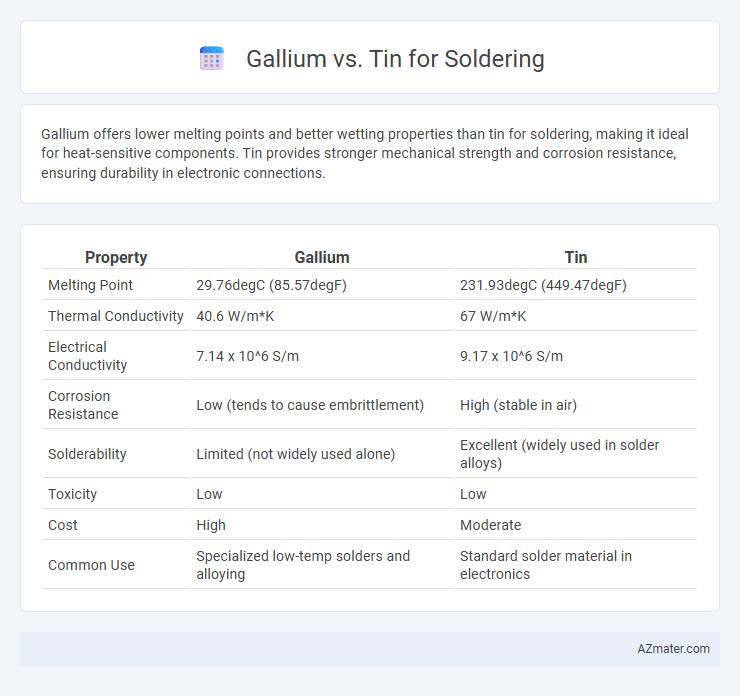Gallium offers lower melting points and better wetting properties than tin for soldering, making it ideal for heat-sensitive components. Tin provides stronger mechanical strength and corrosion resistance, ensuring durability in electronic connections.
Table of Comparison
| Property | Gallium | Tin |
|---|---|---|
| Melting Point | 29.76degC (85.57degF) | 231.93degC (449.47degF) |
| Thermal Conductivity | 40.6 W/m*K | 67 W/m*K |
| Electrical Conductivity | 7.14 x 10^6 S/m | 9.17 x 10^6 S/m |
| Corrosion Resistance | Low (tends to cause embrittlement) | High (stable in air) |
| Solderability | Limited (not widely used alone) | Excellent (widely used in solder alloys) |
| Toxicity | Low | Low |
| Cost | High | Moderate |
| Common Use | Specialized low-temp solders and alloying | Standard solder material in electronics |
Introduction to Gallium and Tin in Soldering
Gallium and tin are essential metals in soldering, with tin widely used for its excellent electrical conductivity and low melting point of 232degC, providing reliable joints in electronics. Gallium, with a melting point of about 30degC, is less common but offers unique properties such as the ability to remain liquid near room temperature, enabling novel applications like low-temperature soldering and flexible electronics. Both metals form the basis for various solder alloys, balancing factors such as melting temperature, mechanical strength, and environmental safety.
Chemical Properties and Composition
Gallium and tin differ significantly in chemical properties and composition, impacting their soldering applications. Gallium is a soft, silvery metal with a melting point of about 29.8degC, easily alloying with metals like aluminum and exhibiting excellent wetting properties on glass and metals. Tin, with a melting point of 231.9degC, is a more stable metal commonly used in solder alloys due to its non-toxic nature and ability to form strong bonds with copper and other metals, making it ideal for electronic soldering and corrosion resistance.
Melting Point Comparison
Gallium has a melting point of approximately 29.76degC, significantly lower than tin's melting point of 232degC, making gallium useful for low-temperature soldering applications that require minimal heat exposure. Tin's higher melting point ensures stronger mechanical bonds and better thermal stability in traditional solder joints used in electronics manufacturing. Choosing between gallium and tin depends on specific project requirements such as operating temperature, mechanical strength, and ease of soldering.
Electrical Conductivity Differences
Gallium exhibits higher electrical conductivity than tin, making it a superior choice for soldering applications requiring efficient current flow. Tin, though commonly used in solder alloys, has lower electrical conductivity, which can result in increased resistance and potential signal loss in high-performance electronic circuits. The conductivity value for gallium is approximately 7.1 x 10^6 S/m, while tin typically measures around 9.17 x 10^6 S/m, indicating tin actually has higher conductivity, but gallium offers benefits in low-temperature melting and wetting behavior.
Wetting and Bonding Capabilities
Gallium exhibits superior wetting properties compared to tin, forming stronger chemical bonds with various metal substrates, enhancing mechanical stability in solder joints. Its lower melting point enables better flow into microscopic crevices, resulting in improved adhesion and electrical conductivity. Conversely, tin, while widely used, often requires flux to achieve comparable wetting and bonding efficiency, especially on oxides or less reactive surfaces.
Corrosion Resistance and Longevity
Gallium offers moderate corrosion resistance but tends to react with many metals, potentially reducing solder joint longevity due to intermetallic compound formation. Tin exhibits superior corrosion resistance in soldering applications, forming stable oxide layers that enhance joint durability over time. Consequently, tin-based solder alloys are generally preferred for reliable, long-lasting electrical and mechanical connections.
Environmental and Safety Considerations
Gallium solder offers a lower toxicity profile compared to tin-lead solder, reducing environmental and health risks during use and disposal. Tin solder, especially lead-free variants, still poses concerns with potential bioaccumulation and inhalation hazards from flux fumes. Proper ventilation and protective equipment are essential regardless of solder choice to minimize exposure to harmful substances.
Practical Applications in Electronics
Gallium offers a lower melting point of about 29.8degC, making it ideal for low-temperature soldering applications and sensitive electronic components where heat damage must be minimized. Tin, with a melting point of 232degC, remains the standard choice for traditional soldering due to its mechanical strength, electrical conductivity, and reliability in forming robust joints in circuit boards. Gallium-tin alloys, such as eutectic mixtures, combine the benefits of both metals, providing practical solutions in specialized electronics manufacturing processes requiring precise temperature control.
Cost and Availability Factors
Gallium solder alloys generally cost more than tin-based solders due to gallium's relative rarity and complex extraction process, impacting budget considerations in electronics manufacturing. Tin is abundant and widely available, ensuring low material costs and consistent supply chains crucial for large-scale production. The higher cost and limited availability of gallium can restrict its use to specialized applications where its unique properties justify the expense over conventional tin solders.
Conclusion: Choosing the Right Soldering Material
Gallium solder offers excellent wetting properties and low melting points, making it ideal for delicate electronic components, but its tendency to cause embrittlement in certain metals limits its use. Tin-based solder remains the industry standard due to its reliable mechanical strength, compatibility with various metals, and ease of use in lead-free formulations like SnAgCu alloys. Selecting the right soldering material depends on application-specific requirements such as operating temperature, mechanical stress, and metal compatibility, with tin alloys generally preferred for durability and gallium for specialized low-temperature applications.

Infographic: Gallium vs Tin for Soldering
 azmater.com
azmater.com